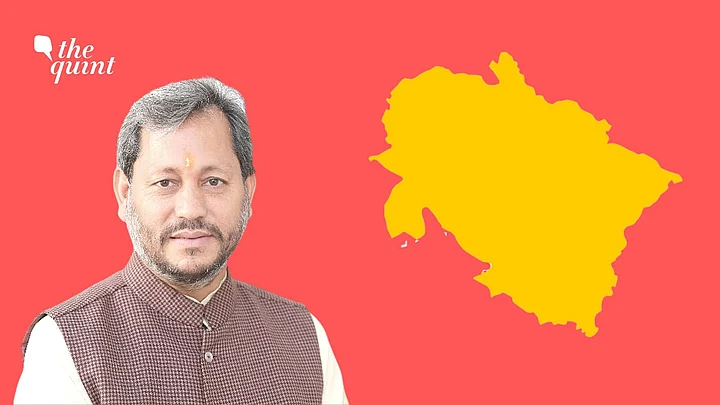Uttarakhand Chief Minister Tirath Singh Rawat has submitted his resignation to the state's Governor Baby Rani Maurya late night on Friday 2 July.
This took place after a day of hectic developments in the past few days - from Rawat being summoned to Delhi, his meeting with BJP president Jagat Prakash Nadda and Union Home Minister Amit Shah and finally his letter to Nadda offering to resign.
He is said to have cited that he cannot continue as CM as an election is no longer possible under Section 151 of the Representation of People Act.
But even when it became clear he was on his way out, Rawat addressed a presser at 9.45 PM in Dehradun on 2 July and curiously made no mention of his resignation. Instead, he merely focused on listing his government's 'achievements' besides announcing a large number of job recruitments in the state.
It is possible that Rawat chose to ignore the resignation issue and instead list his achievements at the presser to give the impression that his removal is only due to a technicality and not poor performance.
The BJP legislative party is likely to meet on Saturday and may possibly elect a new leader.
Uttarakhand will now have its third chief minister in less than six months.
Meanwhile, Rawat is likely to come back to Delhi for the Monsoon Session of Parliament.
Rawat, still an MP from the Garhwal Lok Sabha seat, was made the CM in March replacing an increasingly unpopular Trivendra Singh Rawat.
However, it seems that the change of guard didn't help the BJP. Here are four of the factors that might have contributed to the crisis around Tirath Singh Rawat's continuance.
1. Question of Procedure
Tirath Singh Rawat's main drawback was that he wasn't a member of the Legislative Assembly, which is necessary to become the CM. Since Uttarakhand doesn't have a Legislative Council, Rawat would have had to contest a by-election.
Two seats are presently vacant – Gangotri, which fell vacant after BJP MLA Gopal Singh Rawat died due to COVID-19 in April this year, and Haldwani, which was rendered vacant after Leader of Opposition and veteran Congress leader Indira Hridayesh passed away.
However, there is a rule that bypolls can't be held if Assembly polls are due in less than a year. This is the case in Uttarakhand where the Vidhan Sabha polls are due in early 2022.
This may have been the main reason that put Rawat's position in danger.
2. Fear of Election
But there are said to be provisions for holding the by-election in case there's a constitutional crisis – such as a CM functioning without being a member of the house – even if polls are less than a year away.
It appears that the BJP is reluctant to go down that route and might have preferred to replace him.
The main reason for this could be the fear of a sitting CM losing the bypoll, which would expose the anti-incumbency against the BJP in the state and hand the momentum to the Opposition.
Tirath Singh Rawat's poor performance as the CM and the rising COVID-19 cases didn't help matters. The last thing the BJP would have wanted is a bypoll giving a boost to the Congress.
3. Tough Seats
Haldwani was out of the question as a possible seat for Rawat as it is in the Kumaon region, while he belongs to Garhwal. It is also a relatively strong seat for the Congress.
Gangotri should have been the ideal choice for Rawat but the BJP wasn't sure of his victory there.
The party was facing a great deal of pushback from priests in the temple town, who were opposing the control being exerted on the temple by the state government's Devasthanam's Board.
The priests had been complaining about loss of livelihoods and revenue due to COVID-19 and the lockdown and that the Devasthanam Board had made matters worse.
As an olive branch to the priests, not just in Gangotri but across the state, the state government had announced that it would go ahead with the Char Dham Yatra. But the high court put a stay on this.
Even if Rawat had contested, he would have faced a strong challenge from former MLA Vijay Pal Sajwan of the Congress and AAP's likely CM face Colonel Ajay Kothiyal. Kothiyal had announced on Friday that he would contest from Gangotri if Rawat stood in the bypoll.
4. The Bengal Angle
An outside angle in the mix is West Bengal. Chief Minister Mamata Banerjee was in a similar position as Rawat having become the chief minister despite not being an MLA due to her loss in Nandigram.
Banerjee, too, needs to get elected and the MLA from Bhowanipore has resigned to make way for her.
However, it is possible that the EC would say that elections aren't possible due to COVID-19 third wave, making matters difficult for Mamata.
The BJP would no doubt like to put Mamata in a spot in Bengal after its loss in the Assembly elections. Rawat, therefore, would have to be sacrificed in the process.
Who Could Be the Next CM?
The BJP is likely to avoid a similar dilemma as Rawat's case and choose from among the MLAs, in which case the most likely options could be Dhan Singh Rawat and Satpal Maharaj. Both are prominent leaders who belong to the same Thakur community as Tirath Singh Rawat and are from the Garhwal region.
If BJP considers non-MLAs, then the options could be Anil Baluni and Ramesh Pokhriyal Nishank.
No BJP CM has managed to finish his term in Uttarakhand. The party's first term saw Nityanand Swami and BS Koshiyari as CMs and the second term saw BC Khanduri and Ramesh Pokhriyal Nishank. Even the Congress' last term had two CMs: Vijay Bahuguna and Harish Rawat.
The only CM to complete a term in the state is Congress' ND Tiwari.
